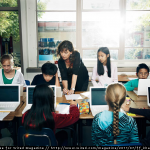 Whilst MOOCs have been attempting to change tertiary education, Khan Academy has been attempting the same with secondary education. With over 1.2 million subscribers, and nearly 300 million views of their videos, they have undoubtedly caused a splash. Schools in California are trialling the so called flipped classroom that sees students watch tutorial videos at home, whilst receiving 1 to 1 tuition and support in the classroom.
Whilst MOOCs have been attempting to change tertiary education, Khan Academy has been attempting the same with secondary education. With over 1.2 million subscribers, and nearly 300 million views of their videos, they have undoubtedly caused a splash. Schools in California are trialling the so called flipped classroom that sees students watch tutorial videos at home, whilst receiving 1 to 1 tuition and support in the classroom.
A study, conducted by Stanford University, explores whether this is in fact the best way to teach our youngsters. The study looked specifically at the study of neuroscience, and looked in particular at how effective the schools own interactive learning environment Brain Explorer was at enhancing neuroscience instruction.
“Our results suggest that students are better prepared to understand a theory after first exploring by themselves, and that tangible user interfaces are particularly well-suited for that purpose,” says Bertrand Schneider, a graduate student who led the research under the direction of Paulo Blikstein, an assistant professor of education.
The researchers collected data from 28 students using Brain Explorer to stimulate how the brain processes visual images. With no previous neuroscience knowledge the group were given a test, with half having simply read text about neuroscience, whilst the other half had access to Brain Explorer.
After receiving the various lessons, the group using Brain Explorer increased their performance by 30% more than the group who only had access to the textbook.
What’s interesting is what happens next. The groups were swapped, so the textbook group then used BrainExplorer, whilst the Brain Explorer group read the text. The students were then tested again.
The results showed a 25% increase in performance in the group who used Brain Explorer first, and textbook study second. A follow up study found identical results when a MOOC style video replaced the textbook.
“We are showing that exploration, inquiry, and problem solving are not just ‘nice to have’ things in classrooms,” says Blikstein. “They are powerful learning mechanisms that increase performance by every measure we have.”
The researchers thus advocate flipping the flipped classroom so that video lectures come after initial exploration of the topic in the classroom, and not before it.
“With this study, we are showing that research in education is useful because sometimes our intuitions about ‘what works’ are simply dead wrong,” says Blikstein.
I see this very much as a positive thing. I'm comfortable with some of the conventions of online/social learning being challenged as it'll help make the whole thing better.
Hi, would appreciate it if the references of these researches are mentioned 🙂 thank you
Here Toni http://www.computer.org/csdl/trans/lt/2013/02/tlt…
Sorry for the late reply, didn't notice I wasn't able to reply back.
Thank you again! 🙂